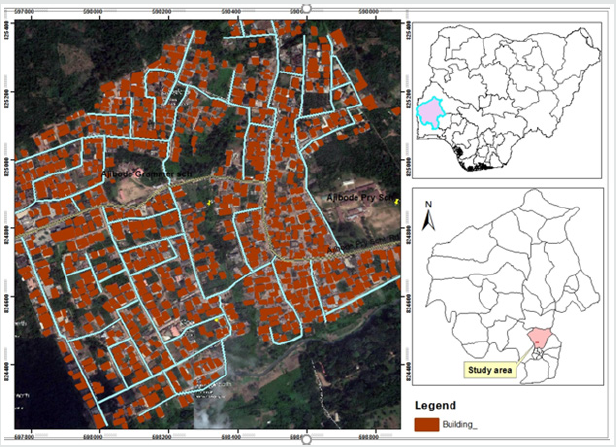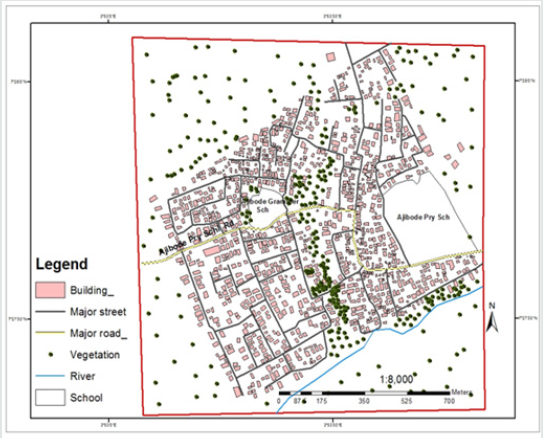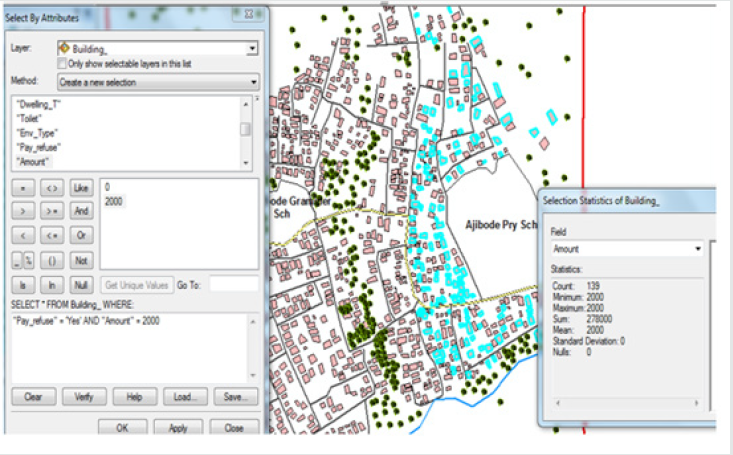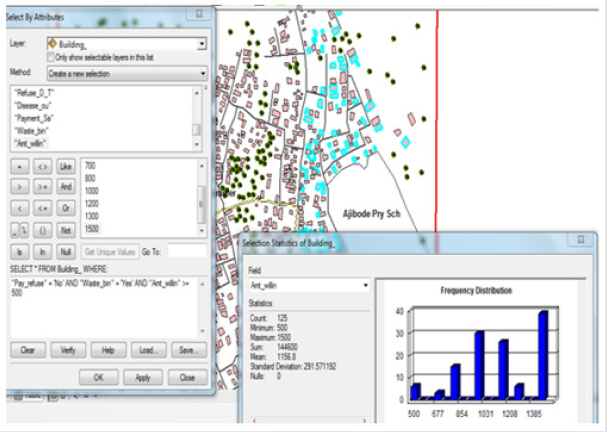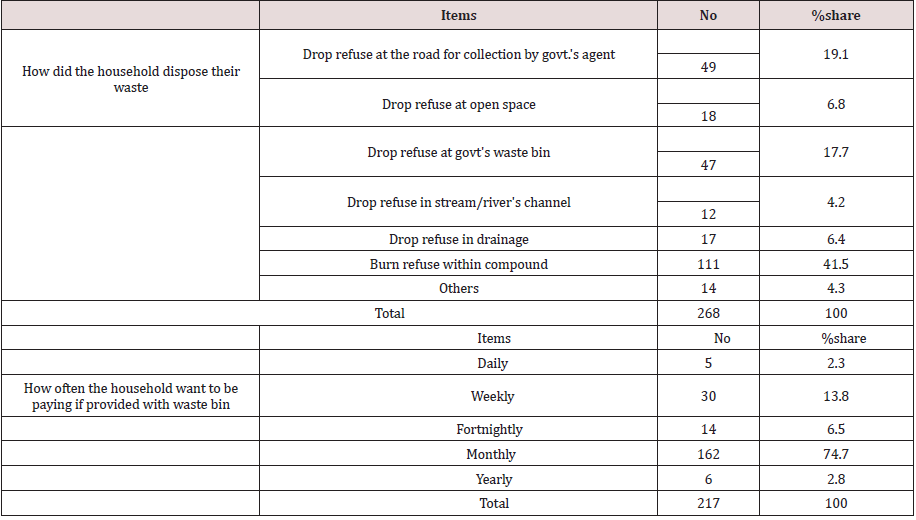
Lupine Publishers Group
Lupine Publishers
Menu
ISSN: 2641-6794
Research Article2641-6794 
Domestic Solid Waste Collection and Payment Policy with GIS Approach in Ajibode, Akinyele Local Government, Oyo - State, (Nigeria) Volume 5 - Issue 4
Oke Mustapha Oludare1* and Olagoke Emmanuel Awodumi2*
- 1Department of Environment and Physical Infrastructure Policy,Nigerian Institute of Social and Economic Research (NISER),Ibadan
- 2Department of Urban and Regional Planning, University of Ibadan, Nigeria
Received: August 17, 2020; Published: September 02, 2020
Corresponding author: Awodumi Olagoke Emmanuel,Department of Urban and Regional Planning, University of Ibadan, Nigeria
DOI: 10.32474/OAJESS.2020.05.000221
Abstract
This study examined the profitability in investing in solid waste management at local government level by private investors. The study employed GIS and remote sensing to analyze the spatial entity and attributes of the 300 selected houses in Ajibode area of Ibadan metropolis. Questionnaire was administered to respondent house owners in the study area. The satellite imagery of the study area was downloaded through Google earth with a spatial resolution of 10 meters above the ground while the coordinates of the survey buildings were obtained through GPS. The study revealed that 39% of existing refuse payers and 35% of dwellers that do not have waste bin but are ready to acquire one in the study area, are ready to pay 1,500 naira conveniently. Also, 25% are willing to pay between 1,200 naira and 1,500 naira. Thus, with 1,000 buildings, the local government or private investors will realize 1.5 million naira per month base on the 1,500 naira payment framework. The study, therefore, suggested that government should make waste bin available for the residences and accept the amount they are willing to pay conveniently. In addition to the associated reduction in unemployment, this it will enhances clean environment by reducing the rate of open space refuse dumping, refuse burning and defecation as well as reducing greenhouse gases, drainage refuse dumping, road side dumping due to these practices. This study serves as a pilot study for both the local governments and private sector willing to invest in the system.
Keywords: GIS and Remote Sensing, Solid Waste Collection, Residential wastebin, pricing policy and revenue
Introduction
The defective strategies and arrangements adopted for solid waste management in Nigerian cities create the erroneous impression that urban waste management problems are intractable. This sterns from the fact that the rate of collection and evacuation perpetually lag behind the rate of generation which makes solid waste accumulation a major source of environmental nuisance in Nigerian cities. Solid waste management, therefore, concerns the interplay among generation, storage, collection, and final disposal [1].Solid waste management is increasingly becoming a concern particularly in highly populated areas. Improper solid waste management leads to both economic and environmental challenge. For instance, uncontrolled throwing of the waste and badly maintained waste results in the growth of diseases as well as increase the presence of unwanted species such as rats and mosquitoes, while bad odor created around the garbage area generates unaesthetic conditions which in turn decrease the market value of the area [2].Waste collection and transport constitutes a large fraction of the total municipal solid waste management costs worldwide. In Greece, currently this may account for 70-100% of the total MSW costs, most of it being spent on salaries and fuel[3]. Unfortunately, many people in African countries including Nigeria still regard the concern for effective strategies for managing urban solid waste as a less important issue which may distract attention from the most urgent and serious problem of achieving a fast rate of economic growth. This attitude stems in part from the belief that environmental degradation with urban solid waste generation is an inevitable price of development [4].
According to Tinmaz and Demir [5], waste has become a critical
issue in development discussions, not because of the quantities of
refuse being dumped, but due to inadequate management system.
One of the major management issues in solid waste management
is improving methods for interpretation of data. Vhora[6]noted
that billions of dollars are spent in improving scientific methods
for interpretation of data, but the steps involved in the said area are
much demanding.
Manual methods used for analysis of factors related to solid
waste management, which largely have a spatial component,
are lengthy and tedious. Difficulty in the assessment of system
functionality and efficiency has been largely associated with
improper management of the data and records, which calls for the
importance of data management in an integrated way so that the
complexity of various systems could be reduced to solve various
interrelated issues. The foregoing underscores the urgent need
for the application of Geographic Information System (GIS) as it is
robust to simultaneous analysis of several factors in planning waste
management. Also, the method possesses layers property which
minimizes chances of confusion and error and can coordinate
between spatial and non-spatial data. In addition, information
can be related spatially, exchanged, compared, evaluated, and
processed with a high flexibility [2]. In fact, Upasna and Natwat
[7] described GIS as a system designed to allow user to collect,
manage, analyze, and retrieve large volume of spatially referenced
data and associated attribute data collected from a variety of
sources. Through different case studies, this paper discussed the
application of GIS in solving problems related to waste storage, then
demonstrating the usefulness of GIS in optimizing waste collection
systems.
Despite waste management being considered as a necessity
and integral to city live ability, urban and environmental policy
makers, especially in most Nigeria States, have not been able to
provide a workable, sustainable and permanent solution to the
indiscriminate disposal of refuse within the urban areas. Channel of
dumping of refuse is one improper method of solid waste disposal
that has been in existence for a long period in the city of Ibadan.
Ye-Obong and Uduak (2013) affirmed that the different categories
of wastes in many Nigerian cities are most times disposed in an
unsustainable manner in open dumps, streets, ravines and also
drainages which then flow into streams that serve as a source of
water to the people residing in such environment. They further
stated that this act of lackadaisical means of disposing refuse has
left the road stinking with odors from decayed sediments and waste
materials which have been left for a long period of time.
Omolawal and Shittu [8] identified a number of micro level
arrangements introduced by state governments to complement
institutional arrangements to enhance environmental sanitation
which include Kerbside sweeping as a way of safeguarding public
health and beautify the environment. This innovation came into
existence in May 1999 as an attempt to make Ibadan city wear a
good look in preparation for the World Youth Soccer tournament
(Nigeria ’99). In addition to street sweepers, approved waste depots
and community waste depots were also used for people in localities
to dump their wastes for eventual collection by the contractors. The
idea is to bring the process close to the doorstep of the masses and
enhance community participation in the process. Waste collectors
are employed by the Ibadan Solid Waste Management Authority
to collect refuse in drums in front of each house under their
jurisdiction and dispose them off.
However, despite all these laudable structures and
arrangements, the streets of Ibadan are still littered with piles of
refuse which disfigure the environment and constitute serious
health challenges. The habit of indiscriminate dumping of refuse on
the streets, open places, drainages, and rivers is continues to be a
menace. Thus, city corridors are now breeding places for rodents,
insects, and diseases. Popoola et al, (2016) stated that inadequate
distribution of refuse bin makes it impossible to establish the
reason behind the indiscriminate disposal of refuse along the road
divide.
Following the problem posed by solid waste collection in Ibadan
urban areas. The pertinent questions are: (1) how can database be
created for houses with waste bins in the city of Ibadan? (2) why
are houses without waste bin, how do they dispose their refuse
and how much are they willing to pay for refuse bin if provided?
(3) How much can government or private sector generate with
the affordable rate? The study therefore creates and designs the
database for houses with existing waste bin in the study area. It
also identifies houses with no waste bin and average amount they
are willing to pay if provided with waste bin. Lastly, it determines
how much government is likely to realize if they comply with the
average amount citizens are willing to pay. This research work will
be of huge significance to the Oyo State Government as it would
inform the State’s strategies towards raising the Internal Generated
Revenue (IGR).
Study Area
Akinyele is a Local Government Area in Oyo State, Nigeria. With coordinates 7°33’41.47” N and 3°54’21.92” E. It is one of the eleven local governments that make up Ibadan metropolis. It was created in 1976, sharing boundaries with Afijio Local Government to the north, Lagelu Local Government to the east, Ido Local Government to the west and Ibadan North Local Government to the south. It occupies a land area of 464.892km2 with a population of 211,811 on a density of 516 persons per km2 which is subdivided into 12 wards. One of them is Ajibode, which is the main focus of this study. It is located in ward 5 at the periphery of Ibadan, sharing boundaries with villages like Apete, Oojo, Moniya, Balogun, Aponmade, Alade, amongst others. The city of Ibadan is known to be the third largest metropolitan area in Nigeria after Lagos and Kano. This is because it is one of the fastest urbanizing cities in Nigeria. The increase in urbanization is attributed to the provision of better economic opportunities due to setting up of factories and industries, which has led to migration of population from rural regions to the city. As a result, people spread to the peripheral areas of the urban fringes. This spread is not properly planned; it looks haphazard thereby causing a lot of health and environmental disturbances to the community. The most versatile land use in Ajibode is purely residential. However, few pieces of land were found scattered around the area on which crops are cultivated as secondary means of livelihood for the residence
Literature Review
Domestic waste form about half of the solid wastes generated
in third world cities Taiwo [9] and over the last ten years,
both domestic and commercial sources of wastes have grown
conspicuously in Nigeria [10,11]. For every good bought, a minimal
addition of waste volume is added to the existing stockpile of waste
at every point in time. This shows the relativity of waste generation
to the population of the society.
Omuta [1]posit that what causes waste problem is not
volume produced but the degree of effectiveness of solid waste
management. However,Rosenbaum [12]argued that solid waste is
an unofficial measure of prosperity since wealthy nations produce
more wastes than poor. Waste storage at the source has also been
described has the second functional element of the solid waste
management. Usually, waste is stored in waste bins located in
both sides of streets next to buildings and other sources of waste
generation. Meanwhile, more attention is given to residential waste
storage due to its direct impact on the public health and attitude,
as these storage points are commonly placed in close proximity
to houses. Due to microbiological decomposition of the waste,
studies have argued against storing waste for long time. According
to Ammar [2], Uncollected garbage causes serious threat to public
health as it is a breeding ground for insects, flies, and bacteria
which this could spread disease.
Uwadiegwu and Chukwu [13] assessed solid waste management
in Enugu cities to develop urban solid waste management strategies
aiming to effectively address the problems emanating from solid
waste management. The authors adopted Principal Components
Analysis (PCA) version of Factor Analysis to analyze the responses
of respondents. The PCA was used to reduce the 27 considered
management options into 7 composite strategies to be adopted for
effective urban solid waste management. Their found that citizen
mobilization and environmental education, strengthening of public
agencies, responsible government, logistics and infrastructural
improvement, legislation, appropriate technologies, monitoring,
and surveillance are effective strategies to checkmate uncontrolled
wasted dumping. Gana and Ngoro [14] posited that the waste
management problem in Nigeria is relatively enormous, and many
attempts made at getting rid of it from human settlement have
not been very successful. In developed countries like Europe,
there are effective systems for the removal of waste from different
settlements, although ultimate and final disposal usually pose
problem in the environment due to lack Basic facilities. In an attempt
to proffer solution to uncontrolled dumping of solid waste along the
major roads, Gana and Ngoro [14] suggested provision of waste bin
and provision of health education for the residents. Adeniran [15]
evaluated the challenges posed by disposal of solid waste on the
built environment in general and specifically on property values by
exploring its impact on the inhabitants and the building structures.
The framework of healthy city concept is used as a standard for
quality while closed and open-ended questions were administered
on randomly sampled 87 residents of Old Bodija, Ibadan and
analysed using simple descriptive analysis. Results revealed that
values of buildings, as well as the physiological welfare of residents,
cannot be isolated from the building and the environment in which
they live vis-à-vis their waste disposal methods[16].
The foregoing indicates that much research have been carried
out to checkmate incessant dumping of refuse along the streets of
Nigerian urban, open space, and drainages with so many statistical
approaches. Surprisingly, little work has yet been done to address
the key issue of effective strategies for the collection of urban solid
waste with Geographical Information Systems and Remote sensing
approach and how this solid waste collection can encourage private
sector or local government to invest into the system and drastically
reduced unemployment in Nigeria cities. This study is therefore
designed to close the identified research gap in literature.
Methodology and Data Acquisition
A GIS involves the acquisition of both spatial and attribute data. As shown in Table 1, the attribute data used for this study came from mainly primary sources. The primary data (questionnaires) such as information about buildings concerning sanitation practices were collected from 300 sample survey buildings and then transferred to ArcMap 10.3 (ArcGIS 10.3) software; the layers were projected into WGS 1984 UTM Zone 31N. each copy of the questionnaire was administered to one household per building. To get high spatial resolution of the study area, the satellite imagery of the study area was downloaded part by part and later mosaics them to a whole Figures1&2. Essential features including roads, buildings and schools digitized in ArcMap. Handheld GPS (Garmin 76) was also used to obtain the coordinates of each of the building under the sample survey.
Georeferenced satellite imagery of the study area was digitized on-screen using ARCGIS 10.3 version. Following the design phase, the database was created and populated in ARCGIS 10.3 environment. Polygon, Line and Point layers were created, respectively. These form individual relations which were then populated with their attribute values.
Analysis and Discussion of Results
Spatial search was used to test the database created by looking for certain attributes within the neighborhood, which must be logically and systematically defined. This gave rise to querying the database towards answering questions related to the application. Some of the information obtained includes the number of houses with and without waste bin, uncompleted buildings, and amount government is expected if complying with the average amount Ajibode dwellers are willing to pay.
Double and Multiple Queries
a) Selection of all the buildings with existing waste bins; pays for refuse collection and amount they pay. Query expression(from all buildings WHERE “pay refuse” = Yes And “Amount” = 2,000).As shown in Figures 3&4, out of 300 sample survey buildings, 139 buildings have refused bin and also pay for waste collection. And it can be deduced that 161 buildings do not have waste bin. Analysis of the Figure shows minimum payment of 2,000 naira and maximum payment of 2,000 naira, which means that the fix regulated amount is 2,000 naira. Due to dwindling economy and so many alternative ways of refuse disposal in the study area and insatiable nature of human being, these existing refuse payers may decide to opt out because of the 2,000-naira payment. Thus, further analysis of houses that are not satisfied with the existing 2,000-naira payment is conducted and how much they are willing to pay.
b) Selections of all the building that pays for refuse collection
but not satisfy with the 2,000-naira amount paying. Query
expression (from all buildings WHERE “pay refuse” = Yes And
“Payment_satisfy” = No and “satisfy_amt_willing”>= 500).
The analysis in Figure 5 indicates that 96 buildings out of 139
buildings that are paying for refuse collection are not satisfied with
the existing 2,000-naira payment and only 43 buildings are satisfy
with the payment. The analysis also revealed that the maximum
amount willing is 1,500 naira which is accounted for 35% of the
buildings. Also, 28% are willing to pay 1,000 naira, 20% are willing
to pay 1,200 naira while the rest are willing to pay less than 1,000
naira.
Figure 5: Query and result of buildings that are not satisfy with the amount being paid and amount they are willing to pay.
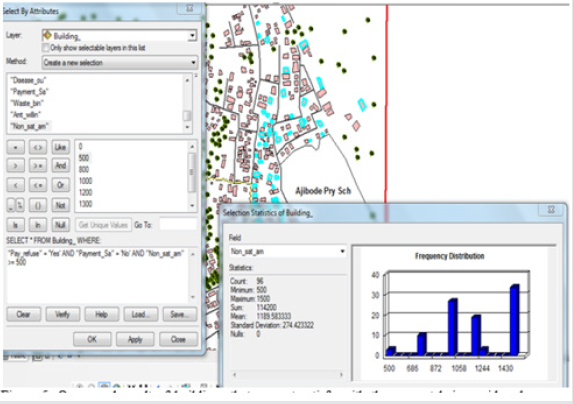
However, for 161 buildings in the sample survey that does not have refuse bin, larger percentage of them burn their refuse within their compound. The analysis in Figure 6 indicates that 125 buildings out of 161 buildings that do not have refuse bin are willing to have and pay for refuse collection. Results also show that maximum amount they are willing to pay is 1,500 naira. While 39% are willing to pay 1,500, 25% are willing to pay 1,200 and 30% are willing to pay 1,000 naira. It can be deduced that the percentage of those that can afford between 1,200 naira and 1,500 naira is 64%. Therefore, in other to persuade these dwellers to make use of refuse bin, it is suggested that government of Oyo State should fix the refuse collection price at 1,500 naira.
c) Selections of all the building that do not have refuse bin neither pays for refuse collection but are willing to have refuse bin if given to them and amount they would want to pay for refuse collection. Query expression (from all buildings WHERE “pay refuse” = No And “Waste bin” = Yes And “Amt_willing”>= 500).From the Figure 6 above, 125 household per building are ready to acquire refuse bin and 39% of them are willing to pay 1500 naira.
As observed from Table 2, 41.5% of the dwellers burn their refuse within their compound, 6.8% of the dwellers drop their refuse in an open space, 4.2% drop their refuse in stream and river channel and 19.1% drop their refuse at the road side to be taken by government agent. Also, only 17.1% of the population has waste bin in their house while 4.3% of the dwellers refuse to give detail of how they dispose their refuse. Furthermore, in terms of frequency of payment for refuse collection, 74.7% choose a monthly payment, 2.3% choose daily plan, 13.8% weekly bases, 2.8%fortnight while less than 1% agreed to a yearly payment.The solid waste collection practice in the study area is well moderated. Door-to-door waste collection, initiated by private organization and supported by state government, was observed. But in some areas, the practice was not so maintained recurrently resulting to jumbled waste disposal. Most of the buildings in the study area have no containers for dumping of solid wastes.
In a sample survey of 300 buildings, this study indicates that
139 buildings have refuse bins of which they pay 2,000 naira as
collection fee. Out of these, only 43 buildings (31%) are satisfied
with the payment, the rest, which accounted for 96 buildings
(69%), are not satisfied with the 2,000 naira payment. it is found
that the highest amount the dwellers are willing to pay is 1,500
naira. While 161 (54%) of the participating buildings do not have
refuse bin, 41.5% of them burn their refuse within their compound,
6.8% drop their refuse at open space, 6.4% in a drainage and 4.2%
in river channels. Moreover, 19.1% dumps their refuse along the
major roads. Among the 161 buildings who do not have refuse bin,
125 building (75%) are willing and ready to have refuse bin if given
to them and 40% of these buildings are willing to pay 1,500 naira
for the refuse collection.
Thus, of the 139 existing refuse payers, about 90% are
willing to pay for refuse collection., If government could fix the
refuse collection fee at 1,500 naira, the amount realize per refuse
collection in a month is 396,000 naira(139existing refuse bin
payers +125 ready to pay for refuse bin =263*1500new price =
396,000). With 1,000 buildings, government will realize 1.5million
naira per months.
Conclusion and Recommendation
It is therefore recommended that the government and private sectors should invest in waste collection system by providing the urban dwellers refuse bin while considering the maximum amount they are willing to pay. This will held to avoid street and open space dumping in Ibadan urban areas, as well as reduce unemployment rate in Oyo State and increase the internal revenue and drastically reduce unemployment in the state. With this amount, the rate of environmental and atmospheric pollution through refuse burning and open space refuse dumping will reduce. With the longstanding challenges of urban solid waste management in the Nigeria, there is the need for the introduction of Waste Management Advisers to the State governors and creation of sanitation committees in the State Houses of Assembly.
References
- Omuta GED (1987) Urban Solid Waste Generation and Management; Towards an Environmental Sanitation Policy. Habitat International 11(2): 77-87.
- Ammar HT (2007) GIS application in solid waste management. An unpublished term paper submitted for Introduction to Geographic Information System (GIS) course work.
- Chalkias C, and Lasaridi K (2009) A GIS based model for the optimization of municipal solid waste collection: The case study of Nikea, Athens, Greece. WSEAS Transactions on Environment and Development 5(10).
- Salau AT (1992) “Global Environmental Change: A Research Agenda for Africa. CODESRIA Working Paper 2: 49.
- Tinmaz E, Demir I (2006) Research on solid waste management systems: To improve existing situation in Corlu Town of Turkey. Science Direct 26(3): 307-314.
- Vohra (2006) notes for the course CE 647 Municipal Solid Waste Management.
- Upasana S, Natwat MS (2003) Selection of potential waste disposing sites around Ranchi Urban Complex using Remote Sensing and GIS techniques. Map India 2003.
- Omolawal SA, Shittu SO (2016) Challenges of solid waste management and environmental sanitation in Ibadan North Local Government, Oyo State, Nigeria. 19(1).
- Taiwo A (2009) Waste management towards sustainable development in Nigeria: A case study of Lagos state. International NGO Journal 4(4): 173-179.
- Babayemi JO, Dauda KT (2009) Evaluation of solid waste generation, categories and disposal options in developing countries: a case study of Nigeria. Journal of Applied Sciences and Environmental Management 13(3): 83-88.
- Oyedepo SO (2012) Energy and sustainable development in Nigeria: the way forward. Energy Sustainability and Society 2: 15.
- Rosenbaum WA (1974) The Politics of Environmental Concern. New York, Praeger (pub).
- Uwadiegwu, Chukwu KE (2003) strategies for effective urban solid waste management in Nigeria. European Scientific Journal 9 (8).
- Gana AJ, Ngoro D (2014) An Investigation into Waste Management Practices in Nigeria (A Case Study of Lagos Environmental protection Board and Abuja Environmental protection Board). West African Journal of Industrial and Academic Research 12 (1).
- Adeniran AA, Elegbede OT, Ogundiran AA (2018) Solid Waste Management and Property Values: Issues and Challenges in Old Bodija, Ibadan, Nigeria. International Journal of Social Science and Humanities Research 6(1): 185-194.
- Udoakah Y and Akpan U (2013) A Sustainable Approach to Municipal Solid Waste Management in Southern Nigeria. A paper presented at the Institute of Electrical Electronics Engineers (IEEE) Global Humanitarian Technology Conference (GHTC) October 20-23, Silicon Valley - San Jose, California, USA.

Top Editors
-

Mark E Smith
Bio chemistry
University of Texas Medical Branch, USA -

Lawrence A Presley
Department of Criminal Justice
Liberty University, USA -

Thomas W Miller
Department of Psychiatry
University of Kentucky, USA -

Gjumrakch Aliev
Department of Medicine
Gally International Biomedical Research & Consulting LLC, USA -

Christopher Bryant
Department of Urbanisation and Agricultural
Montreal university, USA -

Robert William Frare
Oral & Maxillofacial Pathology
New York University, USA -

Rudolph Modesto Navari
Gastroenterology and Hepatology
University of Alabama, UK -

Andrew Hague
Department of Medicine
Universities of Bradford, UK -

George Gregory Buttigieg
Maltese College of Obstetrics and Gynaecology, Europe -

Chen-Hsiung Yeh
Oncology
Circulogene Theranostics, England -
.png)
Emilio Bucio-Carrillo
Radiation Chemistry
National University of Mexico, USA -
.jpg)
Casey J Grenier
Analytical Chemistry
Wentworth Institute of Technology, USA -
Hany Atalah
Minimally Invasive Surgery
Mercer University school of Medicine, USA -

Abu-Hussein Muhamad
Pediatric Dentistry
University of Athens , Greece

The annual scholar awards from Lupine Publishers honor a selected number Read More...





